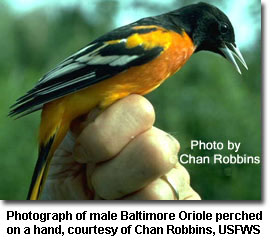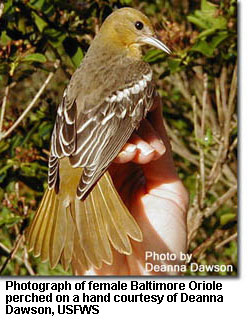Baltimore Oriole
(Icterus galbula)
 Description & Range:
Description & Range:
Male Baltimore Orioles are flame orange and black with a solid black head and orange sides, with orange in the tail. Females and immature Baltimore Orioles are brown above and burnt orange below with two white wing bars. Many adult females have traces of black on their head, suggesting the hood of a male.
Baltimore Orioles are grouped with birds known as Neotropical migrants, birds that breed in North America and winter in Central and South America. Baltimore Orioles rarely winter in Maryland, but can be attracted to backyard feeders in the summer. Look for the migrating orioles to return to Maryland in March through April.
Habitat:
Open deciduous forests, shade trees, and also at backyard feeders.
Diet:
The Baltimore Oriole eats caterpillars (including fall webworm, tent and gypsy moth caterpillars), beetles, scale insects, woodborers, aphids, sawfly larvae, grasshoppers, and others. It supplements its insect diet with fruit. Preferred food trees and shrubs include serviceberry, apple (seeds), mulberry, cherry, blueberry, American mountain ash, and blackberry. Birds will also drink nectar in summer. They are particularly attracted by flowers such as scarlet trumpet honeysuckle called “Dropmore”, hollyhock, rose of Sharon, wood lily, turk’s cap lily and tiger lily.
 Reproduction:
Reproduction:
The Oriole breeds throughout Maryland in large trees in open areas along country roads, in towns, or edges of woods near streams. Favorite nest and shelter trees include maples,sycamore, birches, apples, black cherry, and oaks. The male Baltimore Oriole builds a sturdy pendulous pouch nest. It will accept short pieces of colored yarn (no longer than four inches) for nest building. Female Orioles lay four to six eggs in May through June. Oriole young hatch twelve to fourteen days later and leave the nest twelve to fourteen days after hatching. The bird can be enticed to nest in backyards with the appropriate habitat.
Sounds:
Song is rich with piping whistles. Its call is a low whistled hewli.
Similar Species:
- Orchard Oriole
- Bullock’s Oriole
Population Status:
- Baltimore Orioles have declined significantly in the eastern U.S.
- In Maryland, the decline may approach a rate of 2% annually.
Did you Know?
Baltimore (Northern) Orioles were named because their striking orange and black plumage resembled the coat of arms colors of Sir George Calvert, 1st Lord of Baltimore.